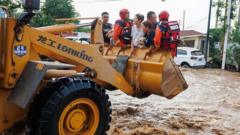In light of the catastrophic events that unfolded this summer, various regions in China are now on high alert as authorities mobilize resources for rescue and recovery efforts.
Heavy rains in northern China have led to tragic flooding, leaving at least 30 people dead and over 80,000 evacuated from their homes, government officials announced. Alongside the fatalities in Beijing, a landslide tragedy in Chengde city claimed eight additional lives. This marks a notable chapter in China's tumultuous summer of extreme weather, where heatwaves and flooding have caused widespread destruction across the nation.
In response to the catastrophe, President Xi Jinping has urged an "all-out" rescue operation, underscoring the government's commitment to minimizing casualties and relocating at-risk residents. As part of the recovery initiative, Chinese authorities have designated 200 million yuan ($28 million) for infrastructure repairs and aid distribution.
Numerous areas on the outskirts of Beijing, particularly Miyun and Huairou, experienced the brunt of the torrential rain. Many roads have been rendered impassable while power has been disrupted to over 130 villages. Disturbing footage captures rescue teams wading through chest-high waters, utilizing helicopters and drones to deliver essential supplies to isolated survivors.
In the wake of this disaster, witnesses have recounted the rapid escalation of the floodwaters. One Taishitun shop owner described how the deluge arrived insidiously, leading individuals to rush for shelter in neighboring buildings while awaiting rescue. Past incidents of flooding, such as the tragic event in July 2012 that left 79 dead, serve as stark reminders of the challenges Beijing faces each summer.
This year, flooding has wreaked havoc beyond the capital, affecting multiple provinces. Earlier this month, two individuals perished amid Typhoon Wipha, while three lives were claimed by a landslide in Ya'an, southwestern China. Experts are increasingly linking these extreme weather events to climate change, raising concerns about their impact on China's economy, especially its crucial agricultural sector. The current year's natural disasters have incurred an estimated cost of 54.11 billion yuan ($7.5 billion), with flooding constituting over 90% of that figure, according to the emergency management ministry.
Heavy rains in northern China have led to tragic flooding, leaving at least 30 people dead and over 80,000 evacuated from their homes, government officials announced. Alongside the fatalities in Beijing, a landslide tragedy in Chengde city claimed eight additional lives. This marks a notable chapter in China's tumultuous summer of extreme weather, where heatwaves and flooding have caused widespread destruction across the nation.
In response to the catastrophe, President Xi Jinping has urged an "all-out" rescue operation, underscoring the government's commitment to minimizing casualties and relocating at-risk residents. As part of the recovery initiative, Chinese authorities have designated 200 million yuan ($28 million) for infrastructure repairs and aid distribution.
Numerous areas on the outskirts of Beijing, particularly Miyun and Huairou, experienced the brunt of the torrential rain. Many roads have been rendered impassable while power has been disrupted to over 130 villages. Disturbing footage captures rescue teams wading through chest-high waters, utilizing helicopters and drones to deliver essential supplies to isolated survivors.
In the wake of this disaster, witnesses have recounted the rapid escalation of the floodwaters. One Taishitun shop owner described how the deluge arrived insidiously, leading individuals to rush for shelter in neighboring buildings while awaiting rescue. Past incidents of flooding, such as the tragic event in July 2012 that left 79 dead, serve as stark reminders of the challenges Beijing faces each summer.
This year, flooding has wreaked havoc beyond the capital, affecting multiple provinces. Earlier this month, two individuals perished amid Typhoon Wipha, while three lives were claimed by a landslide in Ya'an, southwestern China. Experts are increasingly linking these extreme weather events to climate change, raising concerns about their impact on China's economy, especially its crucial agricultural sector. The current year's natural disasters have incurred an estimated cost of 54.11 billion yuan ($7.5 billion), with flooding constituting over 90% of that figure, according to the emergency management ministry.



















